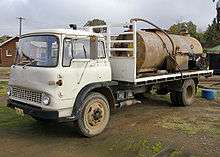Bedford TK
| Bedford TK | |
|---|---|
|
British Army Bedford MK/MJ 4x4 truck | |
| Overview | |
| Manufacturer | Bedford (General Motors) |
| Also called | MK (military model) |
| Production |
1959–1986 (Bedford) 1988-1992 (AWD) |
| Assembly | Dunstable plant, Petone, New Zealand |
| Body and chassis | |
| Class | Commercial vehicle, military vehicle |
| Body style | chassis cab, flatbed, troop carrier, tipper, recovery vehicle |
| Layout |
Longitudinal front engine two-wheel drive (TK) four-wheel drive (MK) |
| Powertrain | |
| Engine | Engine choice was 200 and 220 cubic inch 4 cylinder diesel, 300 and 330 cubic inch 6 cylinder diesel, 214 cubic inch 6 cylinder petrol and on heavier rated chassis the Leyland 6 cylinder diesel. 103 bhp 6-cylinder diesel |
| Transmission | 4-speed manual |
| Dimensions | |
| Wheelbase | 3.962 meter |
| Length | 6.579 meter |
| Width | 2.489 meter |
| Height |
2.501 (cap) and 3.404 (tarpaulin) |
| Kerb weight | 5.1 ton |
| Chronology | |
| Predecessor | Bedford S type |
| Successor | Bedford TL |
The Bedford TK is a truck that was produced by Bedford. Launched in 1959 to replace the Bedford S type, the TK was scheduled to be replaced by the Bedford TL in 1981, but manufacturing of the TK continued as a cheaper alternative. A military 4x4 version called the Bedford MK (later MJ)[1] was also produced. After Bedford's Dunstable factory was sold in 1987 to AWD, the TK restarted production for military only use[2] until 1992 when AWD went into receivership.
History and use

The TK range replaced the S type in 1959, and served as the basis for a variety of derivatives, including fire engines, military, horse boxes, tippers, flatbed trucks, and other specialist utilities. A General Post Office (later British Telecom) version used for installing telegraph poles was known as the "Polecat".
Available with an inline four or inline six cylinder petrol and diesel engines - the TK was the quintessential light truck in the UK through most of the 1960s and 1970s, competing with the similar Ford D series. It was available in rigid form, and also as a light tractor unit normally using the Scammell coupling form of semi-trailer attachment.
In 1981, Bedford introduced turbocharging to the "Red Series" 3.6-litre and 5.4-litre diesel engines, now producing 72 bhp and 102 bhp respectively.[3]
TKs were assembled for many years by General Motors New Zealand Limited at its Petone truck plant. The model was very popular and competed with the like of the also locally assembled Ford D series. It was succeeded by the TM series and GMNZ later switched source to launch a range of Bedford-by-Isuzu models assembled locally from kits shipped from Japan.
MK/MJ
The Bedford MK/MJ - a 4x4 variant of the TK - was used in large numbers by the British Armed Forces and others. The Bedford MK was introduced to replace the Bedford RL. It was very successful and, by year end 1977, a total of 11,700 units had been produced for the British Army and overseas military services. The MK/MJ was produced in many variants. From April 1981, Bedford changed the designation of the MK to MJ as the K multi-fuel engine was superseded by the J diesel engine. It was confirmed in March 2014 that, with the exception of a handful of light recovery vehicles, all British Army Bedford MK/MJ trucks had been disposed of, replaced by RMMV HX60 4x4 trucks.[1]
MK/MJ in popular culture
In the original series of Fireman Sam (1987-1994), Jupiter is a 1974 Bedford TK fire engine.
References
- 1 2 "Bedford MK/MJ (4 × 4) 4,000 kg trucks". IHS Jane's Shaun C Connors, Christopher F Foss and Damian Kemp. 2015-09-23. Retrieved 2015-10-24.
- ↑ "AWD wins MoD order". Commercial Motor. 31 March 1988. p. 15. Retrieved 14 October 2013.
- ↑ "Red Turbo Bedfors". Commercial Motor. 13 June 1981. p. 23. Retrieved 14 October 2013.
| Wikimedia Commons has media related to Bedford TK / MK. |